
Manual shifters for automatic transmissions offer drivers enhanced control‚ blending the convenience of automatic gearboxes with the precision of manual shifting‚ improving performance and efficiency.
1.1 Overview of Manual Shifters
A manual shifter for an automatic transmission is a component designed to provide drivers with more control over gear changes‚ despite the vehicle having an automatic system. It allows for manual gear selection‚ typically through a shift lever or paddles‚ while the transmission still handles clutch engagement automatically. This setup combines the ease of use of an automatic transmission with the driver engagement of a manual system. Modern manual shifters often integrate with electronic systems to optimize performance and responsiveness. They are commonly found in sport-oriented vehicles or cars designed for enthusiast drivers. The shifter operates by sending electronic or mechanical signals to the transmission‚ instructing it to switch gears. This feature enhances driving dynamics‚ particularly in situations requiring precise control‚ such as spirited driving or navigating challenging terrain.
1;2 Importance of Manual Shifters in Modern Vehicles
Manual shifters in modern vehicles play a crucial role in bridging the gap between traditional automatic and manual transmissions. They offer drivers the ability to manually select gears‚ enhancing control and engagement during driving. This feature is particularly valued in sport-oriented vehicles‚ where precise gear changes can improve performance and responsiveness. Additionally‚ manual shifters cater to drivers who prefer a more interactive driving experience‚ even in vehicles equipped with automatic transmissions. By allowing manual gear selection‚ they provide better fuel efficiency in certain driving conditions and enable drivers to adapt to varying road scenarios more effectively. The integration of manual shifters in modern vehicles reflects the evolving demands of drivers seeking both convenience and control.
1.3 Brief History of Manual Shifters
The concept of manual shifters dates back to the early days of automotive history‚ with manual transmissions being the norm; As automatic transmissions gained popularity for their convenience‚ manufacturers sought to retain the driving engagement of manual shifting. The first manual shifters for automatic transmissions emerged in the late 20th century‚ offering a hybrid solution. These systems allowed drivers to manually select gears without the need for a clutch pedal‚ combining the ease of automatics with the control of manuals. Over time‚ advancements in technology led to more sophisticated designs‚ including electronic and paddle-shift systems. Today‚ manual shifters are a common feature in modern vehicles‚ catering to drivers who desire both convenience and driving involvement. This evolution reflects the automotive industry’s continuous pursuit of innovation and driver satisfaction.
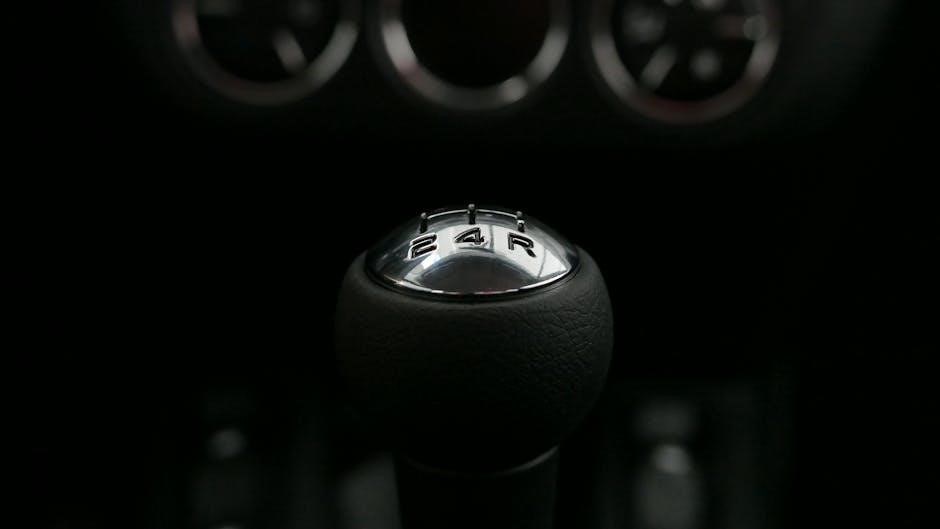
Understanding the Functionality of Manual Shifters
Manual shifters enable drivers to manually select gears in automatic transmissions‚ providing enhanced control over acceleration and performance without the need for a clutch pedal.
2.1 How Manual Shifters Work with Automatic Transmissions
Manual shifters for automatic transmissions allow drivers to manually select gears‚ enhancing control and performance. These systems interface with the transmission’s electronic controls‚ enabling precise gear changes without a clutch pedal. The shifter sends electronic signals to the transmission‚ which then engages the selected gear. This setup combines the convenience of an automatic transmission with the driver engagement of a manual gearbox. The system often includes features like paddle shifters or a gear lever‚ providing intuitive operation. Modern designs integrate advanced software to optimize shifting‚ ensuring smooth transitions and improved fuel efficiency. This functionality bridges the gap between traditional automatic and manual transmissions‚ offering a balance of ease and driver involvement.
2.2 Components of a Manual Shifter System
A manual shifter system for automatic transmissions consists of several key components. The primary element is the shift lever‚ which allows the driver to manually select gears. Connected to this is the shifter module‚ which houses the electronic controls that interpret the driver’s input. Sensors within the module detect the position of the shift lever and transmit signals to the transmission control unit (TCU). The TCU processes these signals and executes the appropriate gear change. Additionally‚ the system may include paddle shifters mounted on the steering wheel for added convenience. These components work in harmony to provide precise control over gear selection‚ enhancing the driving experience. The integration of these parts ensures smooth and efficient operation‚ making manual shifting compatible with automatic transmissions.
2.3 Role of the Shifter in Gear Selection
The manual shifter plays a crucial role in gear selection by allowing the driver to override the automatic transmission’s default operation. It acts as an interface between the driver and the transmission‚ enabling manual control during specific driving conditions. When the driver moves the shifter‚ it sends a signal—either mechanical or electronic—indicating the desired gear; This input is processed by the transmission control unit‚ which then adjusts the gear ratio accordingly. The shifter’s role is to provide tactile feedback‚ ensuring the driver feels connected to the vehicle’s performance. By engaging the correct gear at the right time‚ the shifter enhances acceleration‚ fuel efficiency‚ and overall driving experience. It also empowers the driver to make informed decisions‚ particularly in situations requiring precise control‚ such as uphill climbs or sharp turns.
Types of Manual Shifters for Automatic Transmissions
Manual shifters for automatic transmissions include mechanical‚ electronic‚ and paddle-shift types‚ each offering unique control over gear selection and driving experiences.
3.1 Mechanical Manual Shifters
Mechanical manual shifters are traditional components that provide drivers with physical control over gear selection in automatic transmissions. These shifters are directly connected to the transmission via mechanical linkages‚ allowing precise gear changes. They are often found in performance-oriented vehicles‚ as they offer a more engaging driving experience. The mechanical connection ensures tactile feedback‚ enabling drivers to feel each gear shift. This type of shifter is durable and requires minimal electronic intervention‚ making it a reliable choice. However‚ they can be heavier and require more driver effort compared to electronic or paddle-shift systems. Mechanical shifters are popular among enthusiasts who value the connection to the vehicle’s mechanics and the satisfaction of manual gear control.

3.2 Electronic Manual Shifters
Electronic manual shifters are modern systems that combine the convenience of automatic transmissions with the driver engagement of manual shifting. These shifters use electronic sensors and actuators to control gear changes‚ eliminating the need for mechanical linkages. They are often found in high-performance or luxury vehicles‚ offering precise and rapid shifting. The electronic system allows for features like manual mode and adaptive shifting‚ enhancing the driving experience. Drivers can enjoy better control without the physical effort of a mechanical shifter. Electronic shifters also integrate seamlessly with advanced driver-assistance systems‚ making them a popular choice in modern vehicles. Their reliability and ease of use make them a preferred option for many drivers seeking a balance between convenience and performance;
3.3 Paddle-Shift Manual Shifters
Paddle-shift manual shifters are a modern innovation that combines the convenience of automatic transmissions with the engagement of manual gear control. Typically located on the steering wheel‚ these shifters allow drivers to manually change gears without moving a traditional shifter. This design is popular in performance and luxury vehicles‚ as it enables drivers to maintain control while keeping their hands on the wheel. Paddle-shift systems use electronic or hydraulic actuators to engage gears‚ providing quick and precise shifts. They are often paired with automatic or dual-clutch transmissions‚ offering a blend of convenience and driver involvement. This setup is ideal for spirited driving‚ as it allows for seamless gear changes without the need for a clutch pedal. Paddle-shifters enhance the driving experience by making it more engaging and intuitive.
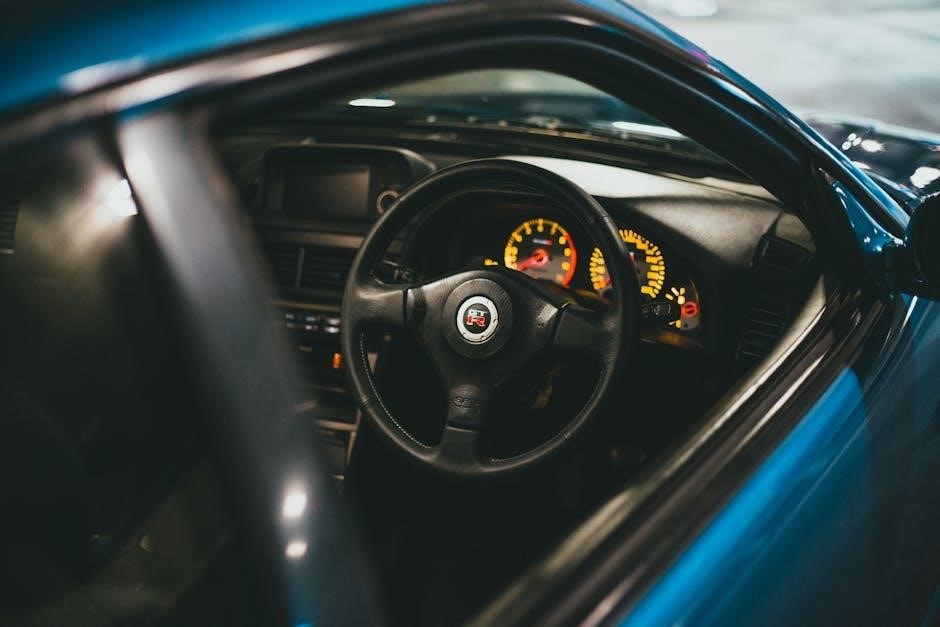
Advantages of Using a Manual Shifter
Manual shifters offer enhanced control‚ improved fuel efficiency‚ and cost-effectiveness. They provide a more engaging driving experience and are often simpler and cheaper to maintain than automatics.
They allow drivers to optimize gear selection‚ reducing wear on the transmission and improving performance in varying driving conditions.
4.1 Enhanced Driver Control
A manual shifter provides drivers with greater control over their vehicle’s performance. By allowing direct gear selection‚ it enables precise torque management‚ especially in dynamic driving conditions.
This capability is particularly beneficial during uphill climbs‚ sharp turns‚ or sudden accelerations‚ where automatic transmissions might hesitate or shift improperly. Drivers can maintain optimal power delivery by manually selecting the right gear‚ enhancing responsiveness and stability; Additionally‚ the tactile feedback from the shifter creates a more engaging and connected driving experience‚ giving motorists confidence in their ability to control the vehicle; This level of command is invaluable for drivers who prioritize precision and responsiveness‚ making manual shifters a preferred choice for those seeking enhanced driving dynamics.
4.2 Improved Performance
Manual shifters significantly enhance a vehicle’s performance by allowing drivers to optimize gear usage. Unlike fully automatic systems‚ manual shifters enable drivers to hold gears longer‚ maximizing acceleration and torque delivery during high-performance driving scenarios.
This feature is particularly advantageous in sporty or dynamic driving conditions‚ where precise gear control can make a notable difference. By avoiding unnecessary automatic shifts‚ drivers can maintain better traction and responsiveness‚ especially on winding roads or during overtaking maneuvers. Additionally‚ manual shifters often include features like rev-matching or downshift blips‚ which further refine acceleration and stability. These capabilities make manual shifters a preferred choice for enthusiasts seeking to extract maximum performance from their vehicles while maintaining control over the driving experience.
4.3 Better Fuel Efficiency
Manual shifters can contribute to better fuel efficiency by allowing drivers to optimize gear usage. By manually selecting gears‚ drivers can shift to higher gears earlier or maintain lower gears when necessary‚ reducing unnecessary engine strain. This level of control is particularly beneficial in city driving or hilly terrain‚ where automatic transmissions might frequently shift gears‚ wasting fuel.
Additionally‚ manual shifters often encourage a more fuel-conscious driving style‚ as drivers are more engaged with the vehicle’s operation. This direct involvement can lead to smoother acceleration and deceleration‚ further enhancing fuel efficiency. Modern systems also integrate with existing fuel-saving technologies‚ ensuring that manual shifting complements rather than hinders efficiency goals.
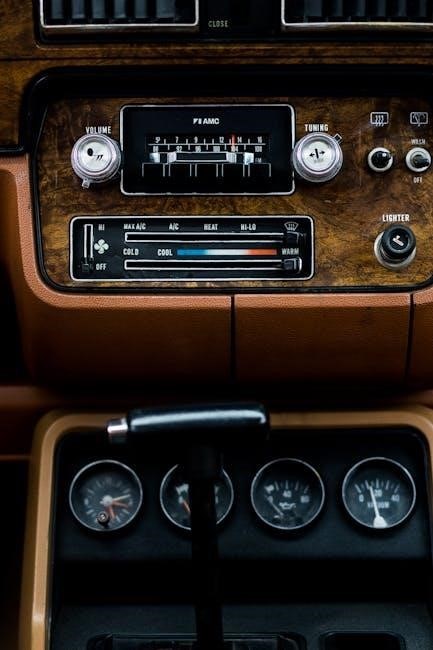
Disadvantages of Manual Shifters
Manual shifters can increase driver effort‚ requiring constant engagement. They may lead to errors for inexperienced drivers and are less convenient in heavy traffic conditions.
5.1 Increased Complexity
Manual shifters add complexity to automatic transmissions by introducing additional components like sensors‚ actuators‚ and software. This integration requires precise synchronization between the shifter‚ transmission‚ and engine. The system must interpret driver inputs accurately‚ which can lead to more potential failure points compared to fully automatic systems. Engineers face challenges in designing intuitive controls while maintaining reliability. The added layers of mechanical and electronic interaction increase the overall system’s intricacy. This complexity can also translate to higher production and development costs. For drivers‚ the learning curve may be steeper‚ especially for those accustomed to traditional automatic transmissions. The increased complexity can sometimes result in a less seamless driving experience if not properly calibrated.
5.2 Higher Maintenance Costs
Manual shifters for automatic transmissions often require more maintenance than traditional automatic systems‚ leading to higher costs over time. The integration of electronic and mechanical components means there are more parts that can wear out or malfunction. Sensors‚ actuators‚ and software systems need regular checks and updates‚ which can be expensive. Additionally‚ the complexity of these systems may require specialized tools and expertise for repairs‚ increasing labor costs. Drivers may also need to replace components like shift modules or solenoids more frequently. While the benefits of manual shifters are clear‚ the added maintenance requirements can strain budgets for vehicle owners. Regular servicing is essential to prevent breakdowns and ensure optimal performance.
5.3 Potential for Driver Error
Manual shifters for automatic transmissions introduce a higher likelihood of driver error due to the increased complexity of operation. Drivers unfamiliar with manual shifting may inadvertently cause premature wear on the transmission or other components by shifting gears roughly or at inappropriate speeds. Additionally‚ there’s a risk of driver distraction as the need to manually shift gears can divert attention from the road‚ increasing the chance of accidents. Novice drivers might experience difficulty in mastering the timing of shifts‚ leading to stalling or jerky movements. Poor ergonomic design of the shifter can also contribute to accidental gear changes. Furthermore‚ in challenging driving conditions such as heavy traffic or rapid acceleration‚ the frequency of shifting can lead to driver fatigue and mistakes. These factors underscore the importance of proper training and practice in using manual shifters effectively.
Installation and Setup of Manual Shifters
Installing a manual shifter for an automatic transmission requires careful planning and precision. Ensure compatibility with your vehicle’s make and model for seamless integration. Proper alignment‚ secure mounting‚ and synchronization with the transmission are critical for smooth operation. Electrical connections for electronic shifters must be handled meticulously to avoid system malfunctions. Always refer to the manufacturer’s instructions and consider professional assistance if unsure. A well-executed installation ensures optimal performance and longevity of the shifter system.
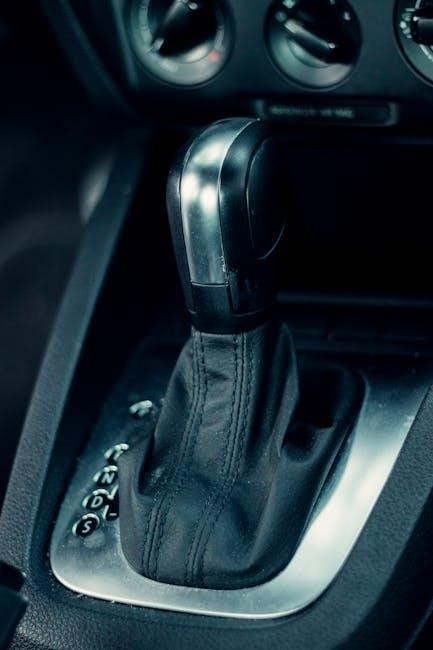
6.1 Step-by-Step Installation Guide
Begin by preparing your vehicle‚ ensuring the transmission is in neutral and the parking brake is engaged. Disconnect the battery to prevent electrical issues. Remove the old shifter and its mounting hardware‚ taking note of the wiring and linkage connections. Install the new manual shifter assembly‚ aligning it with the transmission’s gear selector. Secure it with the provided bolts‚ tightening evenly to avoid misalignment. Connect the shifter cable or electronic sensors to the transmission‚ following the manufacturer’s specifications. Reconnect the battery and test the shifter through all gear ranges to ensure smooth operation. Finally‚ inspect all connections and tighten any loose components for reliability and safety.
6;2 Tools and Materials Required
To install a manual shifter for an automatic transmission‚ you’ll need essential tools and materials. Start with basic tools like screwdrivers‚ wrenches‚ pliers‚ and a socket set. Specialized tools include a shifter alignment tool and a torque wrench for precise bolt tightening. Materials needed are a new shifter assembly‚ mounting hardware‚ and a shifter cable or electronic connector. Lubricants for moving parts and sealants for leaks are also necessary. Ensure you have protective gear like gloves and safety glasses. Additional items may include electrical connectors‚ wiring harnesses‚ and transmission fluid for system checks. Gather all components before starting to streamline the installation process. Always refer to the manufacturer’s specifications for specific requirements tailored to your vehicle.
6.3 Common Installation Mistakes to Avoid
When installing a manual shifter for an automatic transmission‚ several common mistakes can lead to improper function or damage. One of the most frequent errors is misaligning the shifter with the transmission‚ which can result in gears not engaging correctly. Another mistake is using incorrect torque specifications for bolts‚ potentially causing mechanical failure. Forgetting to bleed the system or check transmission fluid levels can also lead to poor performance. Additionally‚ cross-threading bolts or damaging the shifter cable during installation can create long-term issues. Finally‚ not testing the system thoroughly after installation can leave undetected problems. Always follow the manufacturer’s instructions and double-check connections to ensure a smooth and reliable setup. Consulting a professional is advisable if you’re unsure about any step.
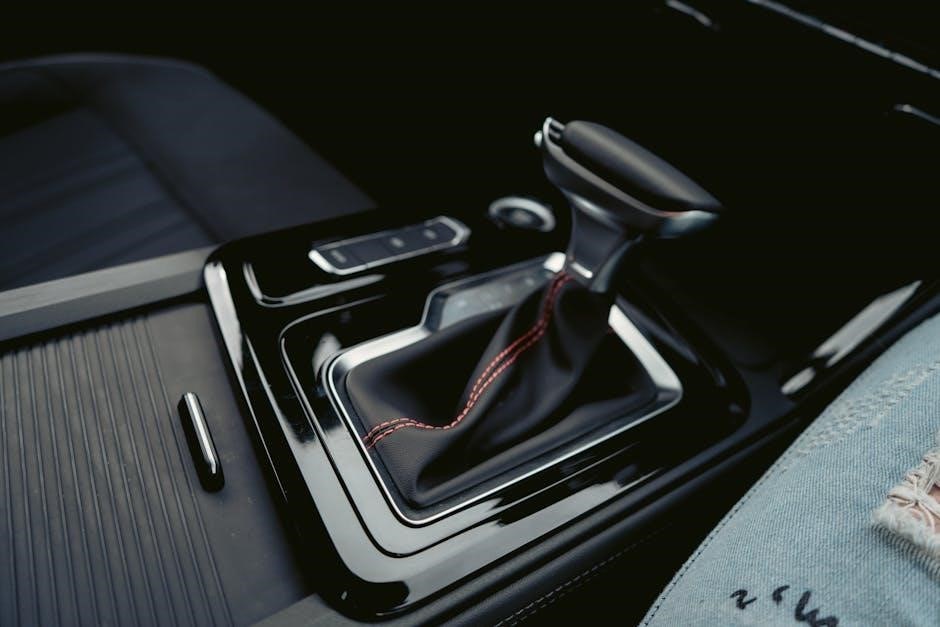
Maintenance and Care for Manual Shifters
Regular maintenance for manual shifters involves inspecting components‚ cleaning‚ and lubricating moving parts to ensure smooth operation‚ prevent wear‚ and maintain optimal performance.
7.1 Regular Maintenance Schedule
A well-planned maintenance schedule is essential for manual shifters in automatic transmissions. Regular inspections should be performed every 15‚000 to 30‚000 miles‚ focusing on the shifter mechanism and linkages.
Check for signs of wear‚ such as loose connections or excessive play‚ and ensure proper lubrication of moving parts. Clean the shifter assembly and apply a high-quality lubricant to maintain smooth operation.
The gear engagement system should also be inspected for alignment and responsiveness. Additionally‚ the transmission fluid level should be checked and topped up as needed to ensure optimal performance.
By adhering to this schedule‚ drivers can prevent potential issues and extend the lifespan of their manual shifter system‚ ensuring reliable and precise gear changes.
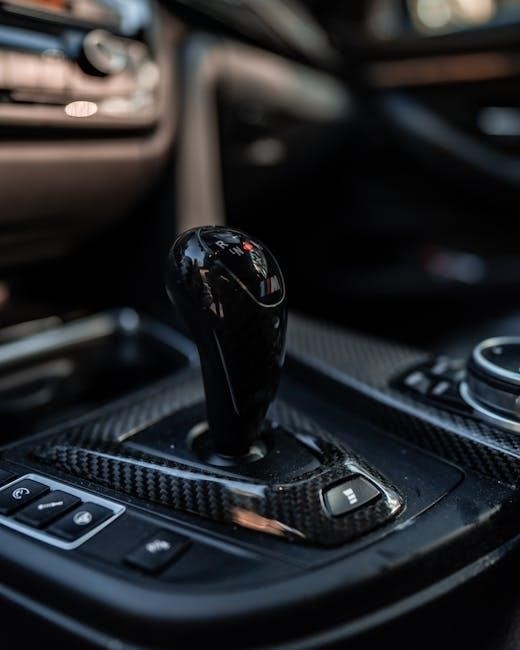
7.2 Cleaning and Lubrication Tips
Cleaning and lubricating your manual shifter regularly can ensure smooth operation and longevity. Start by wiping the shifter handle and surrounding area with a soft cloth to remove dirt and grime. Avoid harsh chemicals‚ as they may damage the materials.
For lubrication‚ use a silicone-based spray on the moving parts of the shifter mechanism. Apply a small amount to avoid attracting dust and dirt. Regular cleaning prevents debris buildup‚ which can cause wear or sticking.
Ensure the shifter linkage is well-lubricated‚ as it connects to the transmission. Over-lubrication should be avoided‚ as it can lead to residue accumulation. Regular maintenance helps maintain precise gear shifts and prevents mechanical issues.
By following these tips‚ drivers can keep their manual shifter functioning optimally‚ ensuring a smooth driving experience.
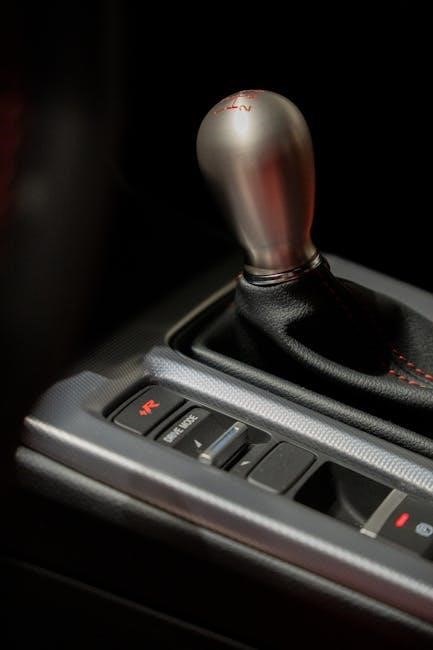
7;3 Signs of Wear and Tear
Identifying signs of wear and tear on a manual shifter for an automatic transmission is crucial for maintaining performance. Common indicators include difficulty in shifting gears‚ such as sticking or hesitation. If the shifter feels loose or has excessive play‚ it may signal worn or damaged components. Grinding or unusual noises during gear changes can also indicate wear on internal parts. Additionally‚ if the shifter slips out of gear unexpectedly‚ it could point to worn detents or springs. Regular inspection of the shifter linkage and bushings for wear or damage is essential. Addressing these issues early prevents further damage and ensures smooth operation. Monitor these signs to maintain the reliability and responsiveness of your manual shifter system.
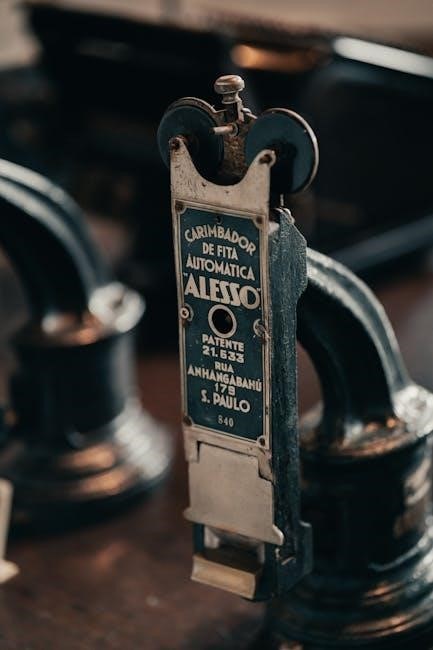
Troubleshooting Common Issues
Troubleshooting manual shifter issues involves identifying symptoms like erratic shifting or gear slippage. Check for low transmission fluid‚ worn clutch packs‚ or faulty solenoids. Diagnose and address problems promptly to prevent further damage.
8.1 Diagnosing Shifter Malfunctions
Diagnosing manual shifter malfunctions starts with identifying symptoms such as erratic shifting‚ gear slippage‚ or failure to engage gears. Use an OBD-II scanner to check for transmission-related error codes. Inspect the shifter’s electrical connections and wiring for damage or corrosion. Low transmission fluid levels or dirty fluid can also cause issues. Test the shifter’s mechanical components‚ such as the linkage or actuator‚ for wear or misalignment. If equipped‚ examine the electronic controls and sensors for proper function. Refer to a repair manual for specific diagnostic procedures. Advanced issues may require specialized tools to test solenoids or valve body operation. Early detection helps prevent further damage to the transmission system.
8.2 Fixing Common Problems
Fixing common manual shifter issues often involves addressing mechanical or electronic faults. For example‚ if gears are not engaging properly‚ inspect and clean the shifter’s electrical contacts or replace worn-out components like bushings or cables. Adjust the shifter linkage to ensure proper alignment with the transmission. If the issue is electronic‚ check and replace faulty sensors or solenoids. Low transmission fluid levels can cause erratic shifting‚ so topping up or changing the fluid may resolve the problem. In some cases‚ reprogramming the transmission control module is necessary. Always refer to the vehicle’s repair manual for specific procedures. If the problem persists‚ consult a professional mechanic to avoid further damage to the transmission system.
8.3 When to Seek Professional Help
It’s crucial to seek professional help when dealing with complex manual shifter issues. If the shifter system malfunctions persistently or causes unpredictable gear shifts‚ a certified mechanic should inspect the problem. Issues like complete loss of manual control or error codes related to the shifter system often require specialized tools and expertise. Additionally‚ if the vehicle’s transmission behaves erratically or slips gears unexpectedly‚ professional intervention is essential to prevent further damage. DIY repairs can sometimes exacerbate problems‚ leading to costly fixes. Always consult a skilled technician for accurate diagnosis and reliable solutions to ensure safety and optimal performance of the manual shifter and transmission system.
Future Trends in Manual Shifter Technology
Future trends include integration with autonomous vehicles‚ adaptive shifters‚ and eco-friendly designs. Advanced electronics and AI will enhance performance‚ safety‚ and personalization‚ transforming the driving experience.
9.1 Integration with Autonomous Vehicles
The integration of manual shifters with autonomous vehicles represents a significant leap in automotive innovation. Autonomous systems will seamlessly blend with manual shifters‚ offering drivers the option to switch between autonomous and manual modes effortlessly. This fusion aims to provide enhanced control and customization‚ catering to both tech-savvy drivers and enthusiasts who value traditional driving experiences. AI-driven systems will optimize gear shifts‚ reducing the need for constant driver intervention while maintaining the thrill of manual operation. Safety features will be prioritized‚ ensuring smooth transitions between autonomous and manual driving. This integration will redefine the role of manual shifters in the era of self-driving cars‚ creating a harmonious balance between technology and driver preference.
9.2 Advancements in Shifter Design
Recent advancements in manual shifter design have focused on creating more intuitive and ergonomic systems. Modern shifters now feature sleek‚ minimalist designs that prioritize both functionality and aesthetics. The use of lightweight materials‚ such as carbon fiber and aluminum‚ has improved durability while reducing weight. Electronic shift-by-wire systems are becoming increasingly popular‚ offering precise control and customizable gear selection. Additionally‚ designers are incorporating adaptive technology that adjusts shifter resistance based on driving conditions‚ enhancing the overall driving experience. These innovations ensure that manual shifters remain relevant in an era dominated by automatic transmissions‚ blending tradition with cutting-edge engineering to meet the demands of modern drivers. The focus is on delivering a seamless and engaging interface between the driver and the vehicle.
9.3 Role of AI in Shifter Systems
Artificial Intelligence (AI) is revolutionizing manual shifter systems by enhancing their intelligence and adaptability. Modern AI-integrated shifters use predictive algorithms to anticipate gear changes based on driving conditions‚ such as acceleration‚ braking‚ and road terrain. This technology optimizes gear selection for smoother transitions and improved performance. AI also enables real-time data analysis from sensors‚ allowing the system to adjust shifting patterns dynamically. Additionally‚ AI can integrate with other vehicle systems‚ like adaptive cruise control‚ to create a seamless driving experience. By learning a driver’s habits‚ AI-powered shifters can personalize gear shifts‚ striking a balance between efficiency and responsiveness. This integration of AI not only enhances driver convenience but also elevates the overall efficiency and performance of automatic transmissions‚ making manual shifters more intuitive and driver-focused than ever before.